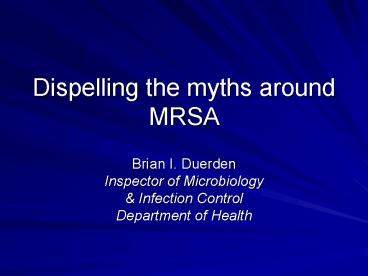Dispelling the myths around MRSA - PowerPoint PPT Presentation
1 / 27
Title:
Dispelling the myths around MRSA
Description:
S. aureus causes INFECTIONS. Wounds (accidental and surgical) boils, abscesses ... nose, axilla (armpit), perineum (groin) 30%(general)-60%(hospital) of population ... – PowerPoint PPT presentation
Number of Views:130
Avg rating:3.0/5.0
Title: Dispelling the myths around MRSA
1
Dispelling the myths around MRSA
- Brian I. Duerden
- Inspector of Microbiology
- Infection Control
- Department of Health
2
What is MRSA?
- Methicillin Resistant Staphylococcus aureus
- S. aureus discovered 1880s
- Infected surgical wounds
- S. aureus causes INFECTIONS
- Wounds (accidental and surgical)
- boils, abscesses
- blood stream infections (bacteraemia)
endocarditis - pneumonia (ICU - ventilators post-influenza)
- CARRIAGE COLONISATION is normal
3
The family Staphylococcus
- Normal habitat skin
- S. epidermidis
- Everyone normal commensal flora
- Harmless (except very susceptible patients)
- Often methicillin resistant
- S.aureus
- CARRIAGE COLONISATION
- nose, axilla (armpit), perineum (groin)
- 30(general)-60(hospital) of population
- chronic skin ulcers etc.
4
MRSA infections
- Wounds
- Post-operative
- Red, inflamed, pus, abscess, breakdown
- Intravenous line infections (bacteraemia)
- Skin ulcers
- Deep abscesses
- Often with bacteraemia
- Pneumonia (lung infection)
- Bacteraemia (bloodstream infection)
5
Properties of MRSA
- Bacterium - non-sporing
- SURVIVES
- on skin/hands, in dust, on surfaces
- Removed by washing (soap water)
- Killed by disinfectants
- ANTIBIOTICS
- Resistant to penicillins cephalosporins
- Resistant or sensitive to gentamicin etc
- Sensitive to vancomycin/teicoplanin, linezolid
and synercid
6
HealthCare Associated Infection
- 9 of hospital inpatients
- urinary (catheter associated)
- blood stream (intravenous line associated)
- wounds (surgical site infection)
- respiratory (ventilator associated pneumonia)
- diarrhoea (C. difficile, antibiotic associated)
- Bacteraemia (blood stream)
- 44 of S. aureus are MRSA
7
2005 -The challenge of HCAI
- MRSA bacteraemia
- 2001/2 7249
- 2002/3 7373
- 2003/4 7684
- 2004/5 7212
- C. difficile infection
- 2001 22008
- 2002 28986
- 2003 35537
- 2004 43672
- Why?
8
1970 2000 a dichotomy
- Microbiology Infection Control
- New antibiotics
- New societies
- New journals
- New guidelines
- New diseases
- Infection control was the province of the IC
specialists
- Modern medicine
- Increased life expectancy
- Cancer treatment
- Immunosuppression
- Complex surgery
- Cardiac, Neuro
- Orthopaedic
- Chronic illnesses
- Renal dialysis
- Infection a nuisance
9
Size of the problem The media view
10
MRSA myths (1)
- New threat never been seen before
11
Evolution of MRSA
- S. aureus (Ogston, 1880s)
- 1940s serious infections no antibiotics
- 1941 penicillin almost all sensitive
- 1959 95 penicillin resistant (penicillinase)
- 1960 methicillin (resists penicillinase)
- 1961 MRSA discovered
- 1970s small numbers of MRSA
- 1980s localised MRSA outbreaks
- 1990s epidemic MRSA strains widespread
12
MRSA myths (2)
- Only a UK problem
13
International comparisons
- Prevalence of HCAI
- USA 5-10
- Australia 6
- Norway 7
- England 9
- Denmark 8
- France 6-10
- Netherlands 7
- Spain 8
- MRSA all S.aureus
- Denmark 1
- Netherlands 1
- Austria 11
- Germany 19
- Spain 23
- France 33
- Portugal 38
- Italy 38
- Greece 44
- UK 44
14
MRSA myths (3)
- Responsible for all HCAI (300,000) and all HCAI
deaths (5000) - ONS Death certificates 2003
- 955 mentions
- 321 principal causes
15
MRSA - not the only one!
- DO NOT NEGLECT
- Clostridium difficile
- Glycopeptide resistant enterococci
- ESBL-producing E. coli etc
- Acinetobacter baumannii
- Norovirus
16
MRSA myths (4)
- MRSA is a death sentence (or severe disability)
- MRSA ve people are a threat to everyone
- ostracism
- Untreatable by antibiotics
- Vancomycin/teicoplanin, linezolid, synercid
17
MRSA myths (5)
- Resistant to disinfectants - NO
- Spreads through air by breathing
- Is everywhere in the hospital environment
- Undercover sampling
- Poor microbiology (dodgy science)
- Tabloid hysteria
18
How do we change bad habits?
- Clinical practice protocols
- Cleanliness and hygiene
- hand hygiene
- environmental cleaning
- Management
- emphasis on infection control
- Training
- Built environment
19
Clinical practice protocols
- GUIDANCE
- handwashing/hand hygiene
- aseptic procedures
- intravenous line management
- urinary catheter care
- endotracheal tube care
- risk-assessed admission screening
- APPLICATION OF
- audit tool, root cause analysis, HACCP
20
Renal Association SA Standards
- Recommendations (August 2002)
- IC policy for MSSA/MRSA
- Screening, prophylaxis, treatment, education,
hand hygiene, isolation - 3-monthly screen for nasal SA carriage
- Temporary venous catheter mupirocin or povidone
iodine at end of session - HD SA carriers mupirocin /- weekly mup.
- PD mupirocin daily/alt. days to exit site
- PD SA carriers mupirocin erad. or 5 d/4 w
21
Audit
- Is it being done?
22
Cleanliness and Hygiene
- Contracted out versus in house
- commitment
- Role of the TEAM
- Modern Matron
- Ward Sister staff
- Ward Housekeeper
- Cleaners
23
Management
- Director of Infection Prevention Control
- accountability, responsibility, authority
- Bed/patient management
- occupancy challenge (lt85 desirable)
- moving around wards/hospital
- mixing elective and emergency admissions
24
Training
- For all staff clinical non-clinical
- Professional training
- Undergraduate (GMC Medical Schools)
- Postgraduate (Foundation years Specialist
training Postgraduate Deans Royal Colleges) - Personal development plans
- CPD appraisal
25
Built environment
- Age, maintenance
- Single rooms ( aim for 50)
- ventilated lobbies
- Maximum 4 beds per bay
- Design
- no ledges, no carpets, sealed/coved floors,
impervious soft furnishings - Ventilation
26
A wake-up call..
- We have accepted these infections as normal
- Patients
- Can be very ill
- Can die
- Stay in hospital longer
- May need major surgery
- Significant NHS resources could be better used
27
Reducing MRSA HCAIs
- Clinical teams
- Infection control teams
- Management teams































